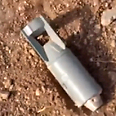
Incendiary bomb

Aleppo in ruins
Photo: Reuters
Syrian forces have dropped incendiary bombs on populated areas, Human Rights Watch said on Wednesday, calling on the authorities to stop using a weapon that causes "especially cruel human suffering".
Most of the weapons found appeared to be two kinds of Soviet models, one of which releases 48 incendiary submunitions over an area the size of a football field, it said.
Related stories:
- Report: Syria rebels seize key Aleppo base
US blacklists al Qaeda-linked Syrian rebel group
Report: Israel tracking Syria's WMD arsenal
Incendiary weapons contain flammable materials such as napalm, thermite or white phosphorous, which can set fire to buildings or cause severe burns and respiratory damage.
"These weapons cause especially cruel civilian suffering and extensive property destruction when used in populated areas," said Steve Goose, director of the arms division of the New York-based rights group.

Shelling in Homs (Photo: Reuters)
"Syria should stop using incendiary weapons in acknowledgment of the devastating harm these weapons cause."
The group said it based its findings on interviews with witnesses and by analyzing videos uploaded by activists. It concluded that at least four areas had been hit by such bombs – two towns near the capital Damascus, one in the northern province of Idlib and a town in central Homs province.
HRW is still investigating use of the weapons in other areas.
The injury caused by incendiary bombs is compounded in hard hit areas in Syria, where infrastructure has been destroyed by clashes in its 20-month-old revolt and hospitals in rebel-held areas have been badly by army shelling.
"The burns are difficult to treat, especially in conflict areas lacking adequate medical facilities, and the treatment itself can be excruciating," the HRW report said. "Permanent scarring and disfigurement can lead to social ostracism."
The bombs used by Syrian government forces mostly contained thermite, HRW said, citing independent arms analyst Nic Jenzen-Jones.
"Thermite is used only for its incendiary effect and not for marking, obscuring, illumination or other purposes," HRW said.
Activist accounts described bombs dropped from Russian MiG fighter jets, exploding in mid-air before releasing fireballs over a wider area.
Syria has not signed the 1980 Convention on Conventional Weapons which includes restrictions on the use of incendiary weapons in areas with large civilian populations.
HRW said it did not know the size of Syria's incendiary weapon stockpile which it believed was supplied by the former Soviet Union.
Incendiary weapons are not chemical arms, which Western powers have warned Syrian authorities not to use in their fight against rebels seeking to oust President Bashar Assad.
Western officials cited US intelligence they say showed Syria might be preparing to use poisonous gas, but Washington later said the movement of weapons appeared to have halted.
Damascus says it would never use chemical weapons against its own people and that the reports aimed to whip up support for international intervention. Washington has said the use of chemical weapons would cross a "red line."
- Receive Ynetnews updates
directly to your desktop















